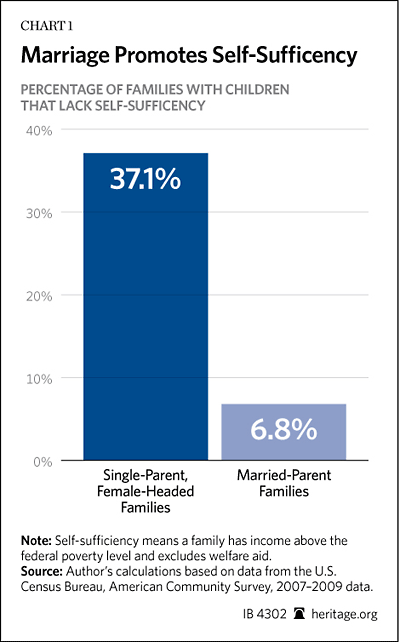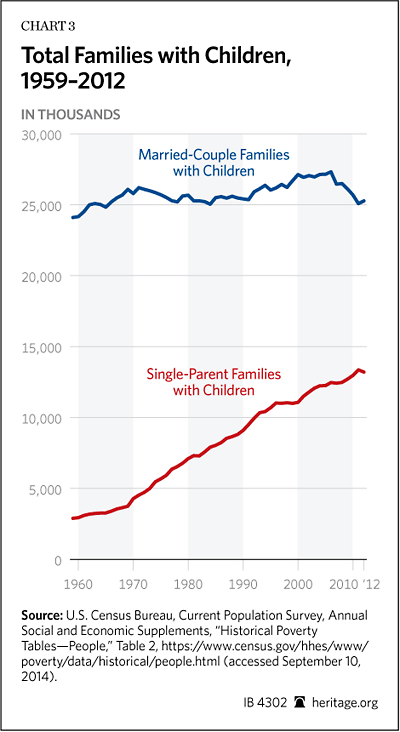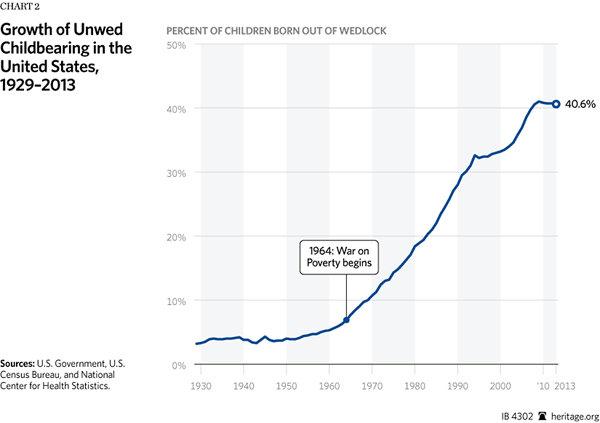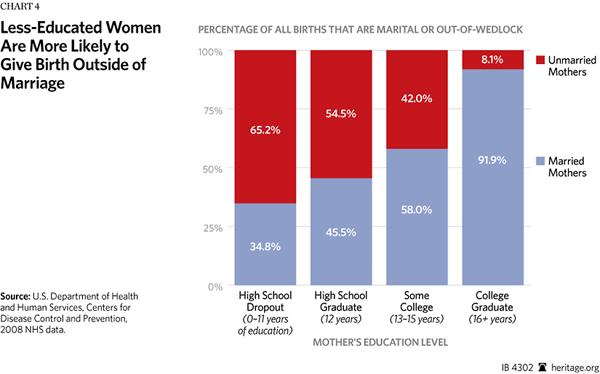Historically, marriage has played a critical role in the raising of children. In most cases, the economic benefits of marriage are substantial. Marriage among families with children is an extremely powerful factor in promoting economic self-sufficiency: the ability of families to support themselves above poverty without reliance on government means-tested welfare aid. The reason for this is simple and straightforward. In most cases two parents working together can support a child more efficiently than one. For example, as Chart 1 shows, some 37 percent of single-parent families lack self-sufficiency (and are officially poor) compared with 7 percent of married-couple families.

The Benefits of Married Fathers for Children
Marriage provides positive impacts well beyond self-sufficiency, but the positive effects of marriage are not limited to self-sufficiency. Children raised by married parents have substantially better life outcomes compared with similar children raised in single-parent homes.[1]
When compared with children in intact married homes, children raised by single parents are more likely to have emotional and behavioral problems; be physically abused; smoke, drink, and use drugs; be aggressive; engage in violent, delinquent, and criminal behavior; have poor school performance; be expelled from school; and drop out of high school. Many of these negative outcomes are associated with the higher poverty rates of single mothers. In many cases, however, the improvements in child well-being that are associated with marriage persist even after adjusting for differences in family income. This indicates that the father brings more to his home than just a paycheck.[2]
The effect of married fathers on child outcomes can be quite pronounced. For example, examination of families with the same race and same parental education shows that, compared with intact married families, children from single-parent homes are:
- More than twice as likely to be arrested for a juvenile crime,[3]
- Twice as likely to be treated for emotional and behavioral problems,[4]
- Roughly twice as likely to be suspended or expelled from school,[5] and
- A third more likely to drop out before completing high school.[6]
The effects of being raised in a single-parent home continue into adulthood. Comparing families of the same race and similar incomes, children from broken and single-parent homes are three times more likely to end up in jail by the time they reach age 30 than are children raised in intact married families.[7] Compared with girls raised in similar married families, girls from single-parent homes are more than twice as likely to have a child without being married, thereby repeating the negative cycle for another generation.[8]
Finally, the decline of marriage contributes to declining self-sufficiency and increased official poverty in future generations. Children living in single-parent homes are 50 percent more likely to experience official poverty as adults when compared with children from intact married homes. This intergenerational poverty effect persists even after adjusting for the original differences in family income and poverty during childhood.
The War on Poverty and the Decline of Marriage
As Chart 2 shows, throughout U.S. history, marriage was the norm. Prior to the mid-1960s, nearly all children were born to married couples. When the War on Poverty began in 1964, only 7 percent of children were born to unmarried women. However, over the next four-and-a-half decades the share of non-marital births exploded. In 2013, 41 percent of all children born in the U.S. were born outside marriage.
Chart 3 shows the rapid growth of single-parent families from another perspective. As the chart shows, there has been no significant increase in the number of married-couple families with children in the U.S. since 1965. By contrast, the number of single-parent families with children has skyrocketed by nearly 10 million, rising from 3.3 million in 1965 to 13.2 million in 2012. Since single-parent families are roughly four times more likely to lack self-sufficiency (and be officially poor), this unravelling of family structure has exerted a powerful downward pull against self-sufficiency and substantially boosted the official child poverty rate. When the War on Poverty began, 36 percent of poor families with children were headed by single parents. Today, the figure is 68 percent.

A Two-Caste Society
Non-marital child bearing is not uniformly spread across U.S. society. Most non-marital births occur to women who will have the hardest time going it alone as single parents: young adult women with a high school degree or less. As Chart 4 shows, nearly two-thirds of births to women who were high school dropouts occurred outside marriage. Among women who had only a high school degree, well over half of all births were outside marriage. By contrast, among women with at least a college degree, only 8 percent of births were to single women, while 92 percent of births occurred to married couples.
The U.S. is steadily separating into a two-caste system with marriage and education as the dividing line. In the high-income third of the population, children are raised by married parents with a college education; in the bottom-income third, children are raised by single parents with a high school degree or less.
Welfare and the Decline of Marriage
It is no accident that the collapse of marriage in America largely began with the War on Poverty and the proliferation of means-tested welfare programs that it fostered. When the War on Poverty began, only a single welfare program—Aid to Families with Dependent Children (AFDC)—assisted single parents. Today, dozens of programs provide benefits to families with children, including the Earned Income Tax Credit (EITC), Temporary Assistance for Needy Families (TANF), the Women, Infants and Children (WIC) food program, Supplemental Security Income (SSI), food stamps, child nutrition programs, public housing and Section 8 housing, and Medicaid. Although married couples with children can also receive aid through these programs, the overwhelming majority of assistance to families with children goes to single-parent households.
The burgeoning welfare state has promoted single parenthood in two ways. First, means-tested welfare programs such as those described above financially enable single parenthood. It is difficult for single mothers with a high school degree or less to support children without the aid of another parent. Means-tested welfare programs substantially reduce this difficulty by providing extensive support to single parents. Welfare thereby reduces the financial need for marriage. Since the beginning of the War on Poverty, less-educated mothers have increasingly become married to the welfare state and to the U.S. taxpayer rather than to the fathers of their children.
As means-tested benefits expanded, welfare began to serve as a substitute for a husband in the home, and low-income marriage began to disappear. As husbands left the home, the need for more welfare to support single mothers increased. The War on Poverty created a destructive feedback loop: Welfare promoted the decline of marriage, which generated a need for more welfare.
Penalizing Marriage
A second major problem is that the means-tested welfare system actively penalizes low-income parents who do marry. All means-tested welfare programs are designed so that a family’s benefits are reduced as earnings rise. In practice, this means that, if a low-income single mother marries an employed father, her welfare benefits will generally be substantially reduced. The mother can maximize welfare by remaining unmarried and keeping the father’s income “off the books.”
For example, a single mother with two children who earns $15,000 per year would generally receive around $5,200 per year of food stamp benefits. However, if she marries a father with the same earnings level, her food stamps would be cut to zero. A single mother receiving benefits from Section 8 or public housing would receive a subsidy worth on average around $11,000 per year if she was not employed, but if she marries a man earning $20,000 per year, these benefits would be cut nearly in half. Both food stamps and housing programs provide very real financial incentives for couples to remain separate and unmarried.
Overall, the federal government operates over 80 means-tested welfare programs that provide cash, food, housing, medical care, and social services to poor and low-income individuals. Each program contains marriage penalties similar to those described above. Low-income families generally receive benefits from several programs at the same time. The marriage penalties from multiple programs when added together can provide substantial financial disincentives to marriage. For example, if a single mother who earns $20,000 per year marries a man who earns the same amount, the couple will typically lose about $12,000 a year in welfare benefits. In effect, the welfare system makes it economically irrational for most low-income couples to marry.
The anti-marriage aspect of the welfare state can be illustrated by comparing means-tested welfare with the federal income tax code. For example, under a progressive income tax system with only a single schedule of tax rates indiscriminately covering both single persons and married couples, nearly all individuals would experience an increase in taxes owed when they married and lower taxes if they remain separate or divorce. The current federal income tax system mitigates this anti-marriage effect by having separate tax schedules for singles and married couples.
By contrast, the means-tested welfare system, in most cases, does not have a separate schedule for married couples. When a low-income mother and father marry, they will generally experience a sharp drop in benefits, and their joint income will fall. The anti-marriage penalty is often most severe among married couples where both parents are employed.
Reducing Marriage Penalties
These anti-marriage penalties are harmful to mothers, fathers, children, and society at large. Reform is needed. Yet with over 80 different means-tested aid programs, the U.S. welfare system is very complex. Eliminating all anti-marriage incentives in these programs overnight would be very expensive. However, policymakers can reduce welfare’s anti-marriage penalties incrementally.
A positive first step in this incremental process would be to reform the EITC. For the most part, the EITC provides refundable tax credits (i.e., cash benefits) to low-income parents who have no federal income tax liability. The EITC is superior to all other means-tested welfare programs because parents must work in order to be eligible for benefits. In contrast to other welfare programs, the EITC has slightly different benefit schedules for married couples and single parents. These mitigate, but do not eliminate the anti-marriage incentives provided by the program. Policymakers should build on the strengths of the EITC by toughening its work standards, preventing fraud, and further reducing its marriage penalties.[9] A properly reformed EITC could begin to offset the marriage penalties in other welfare programs.
By contrast, increasing the EITC for unmarried fathers who do not support their children is a bad policy that intensifies the anti-marriage incentives within the welfare system. Such a policy would increase overall welfare benefits for parents who do not marry and increase the benefits lost when the couple does marry.
Conclusion
Marriage is good for children, mothers, and fathers, but marriage is disappearing in low-income communities. In part, this is due to the fact that the U.S. welfare system actively penalizes many low-income parents who do marry. The anti-marriage incentives built into the welfare state are indefensible. Policymakers should reduce welfare’s anti-marriage penalties.
—Robert Rector is Senior Research Fellow in the Richard and Helen DeVos Center for Religion and Civil Society and the Domestic Policy Studies Department, of the Institute for Family, Community, and Opportunity, at The Heritage Foundation.





